
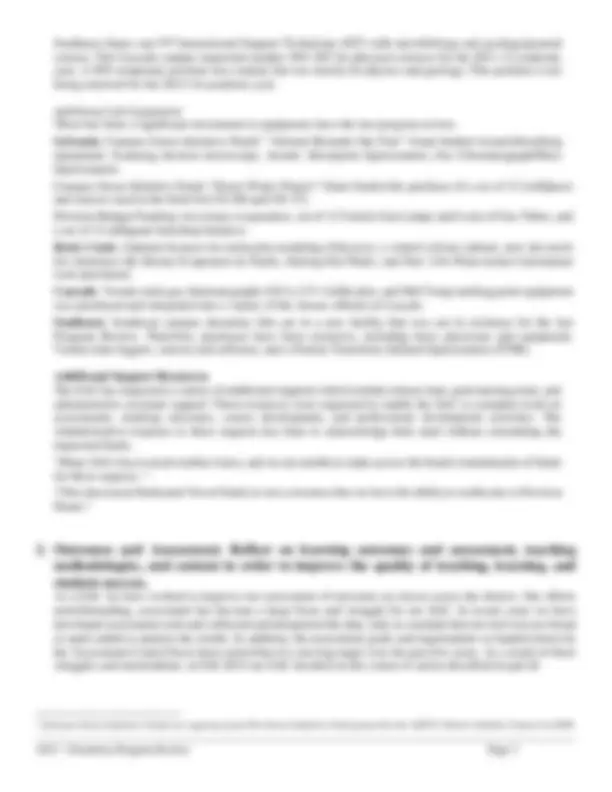
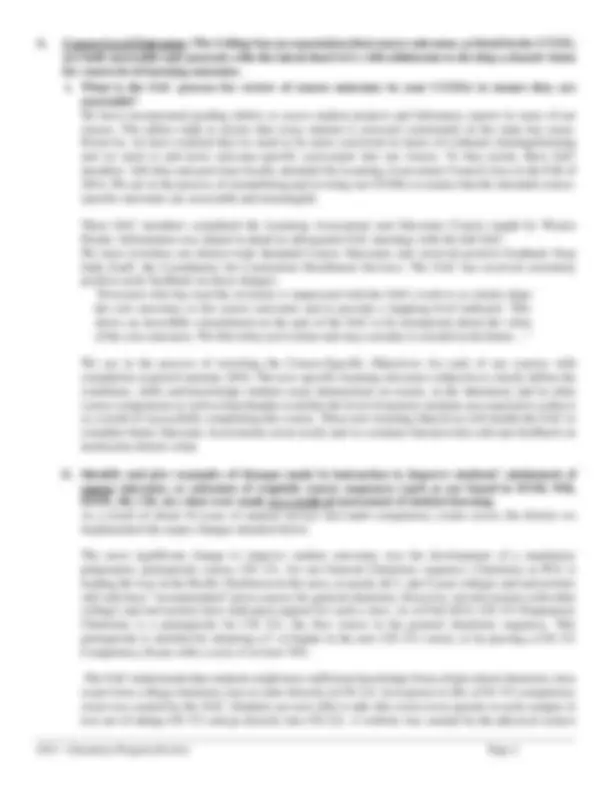
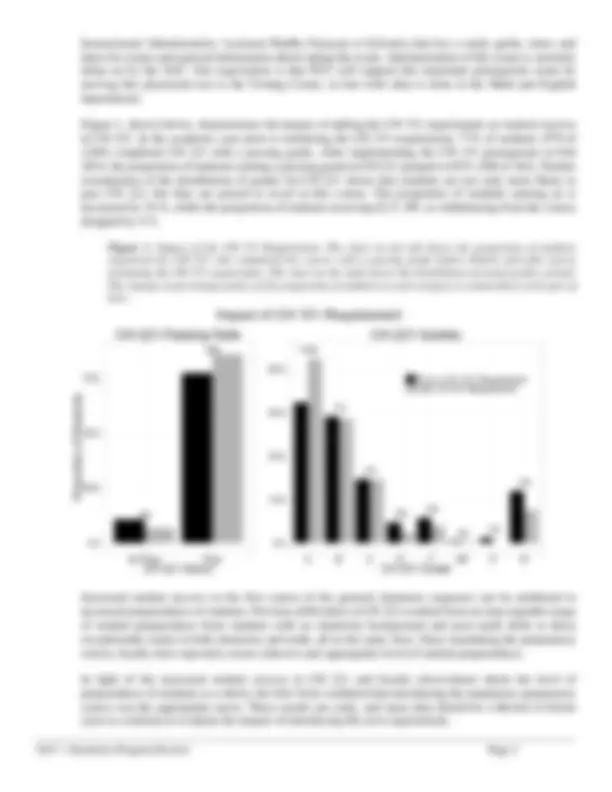
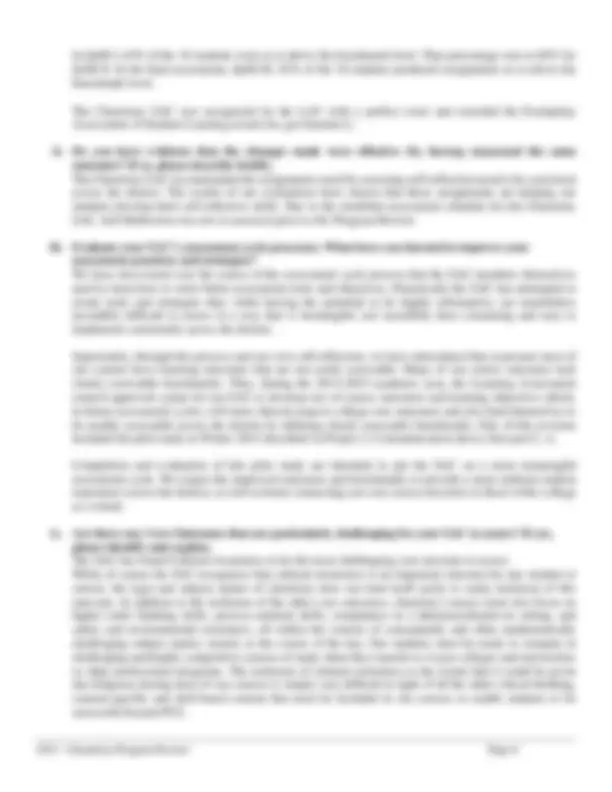
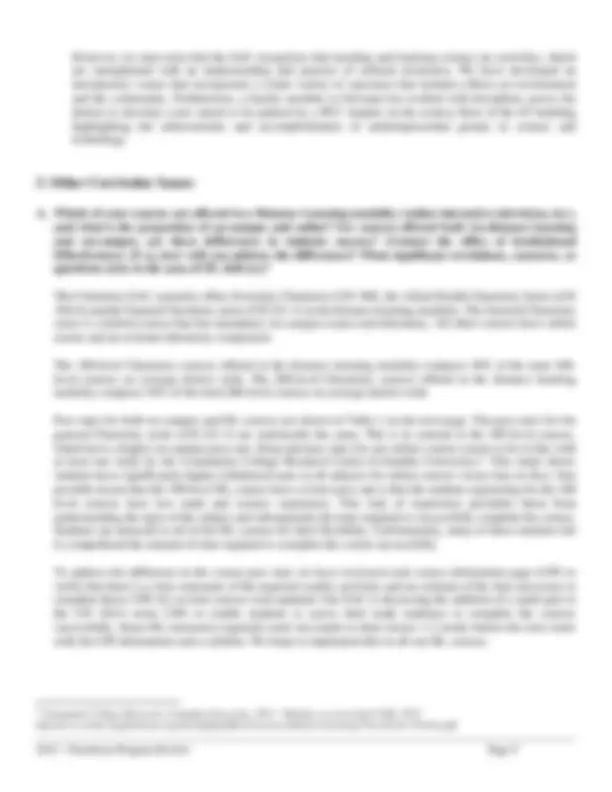
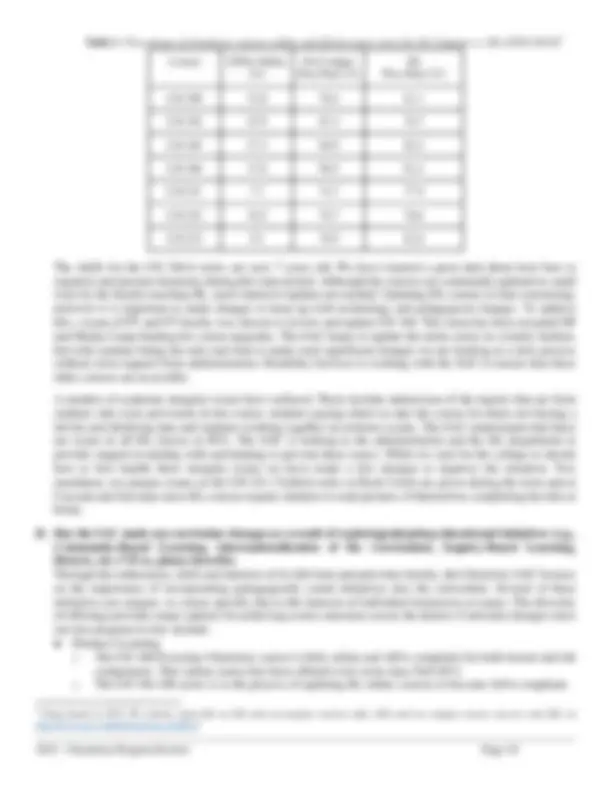
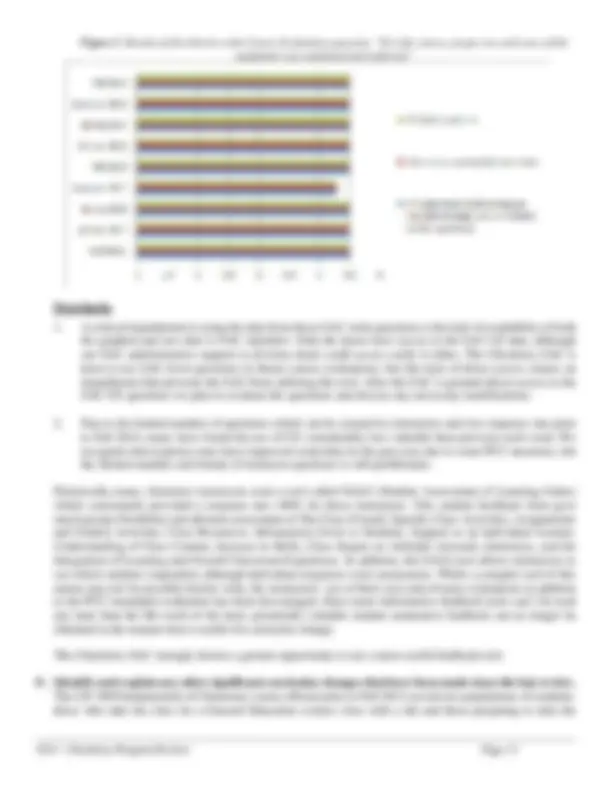
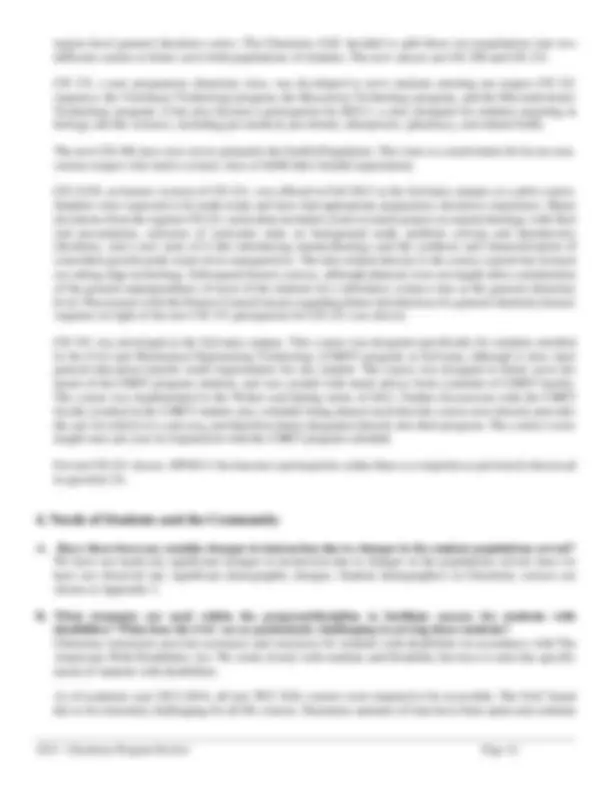
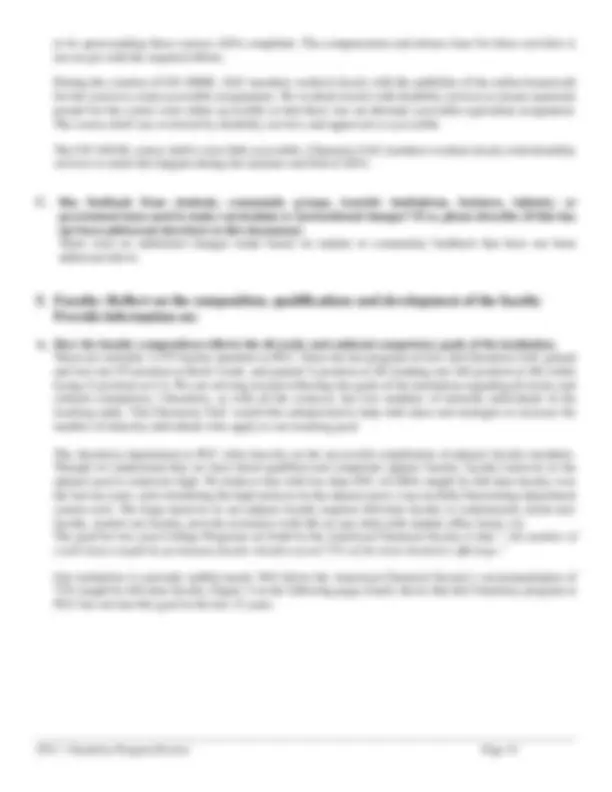
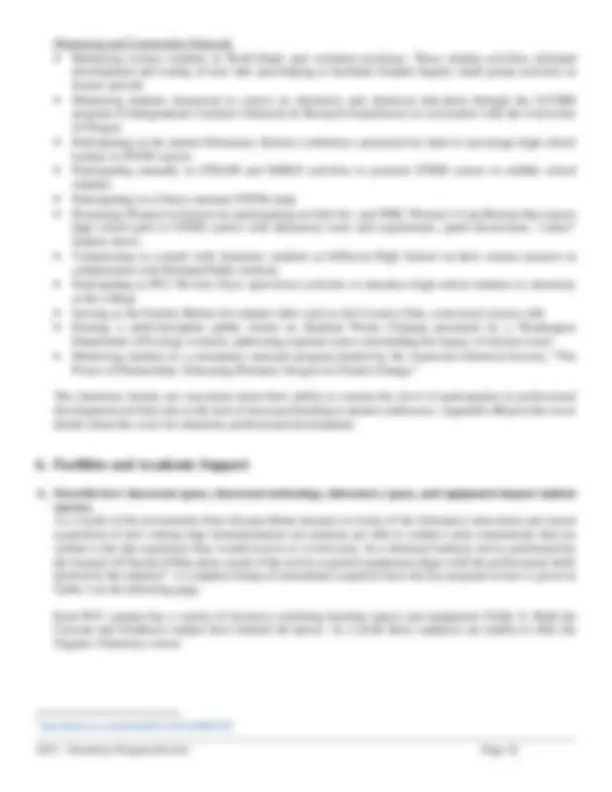
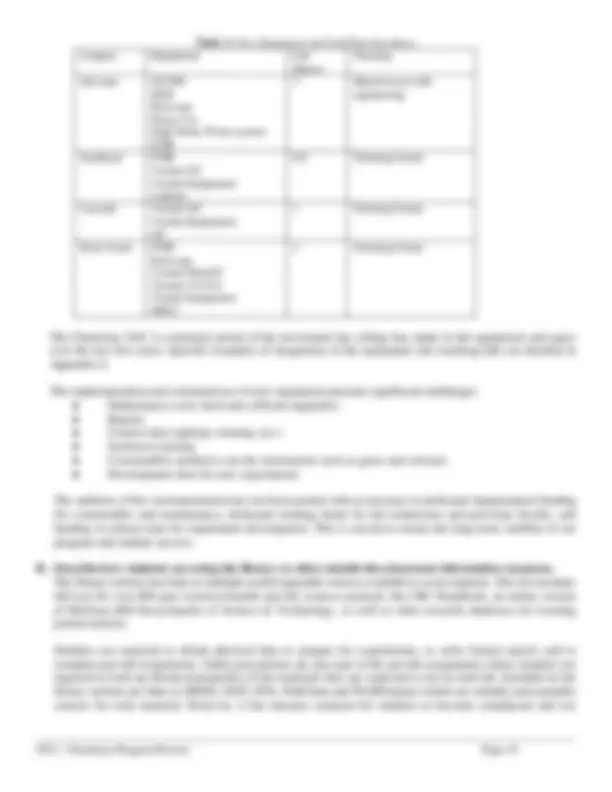
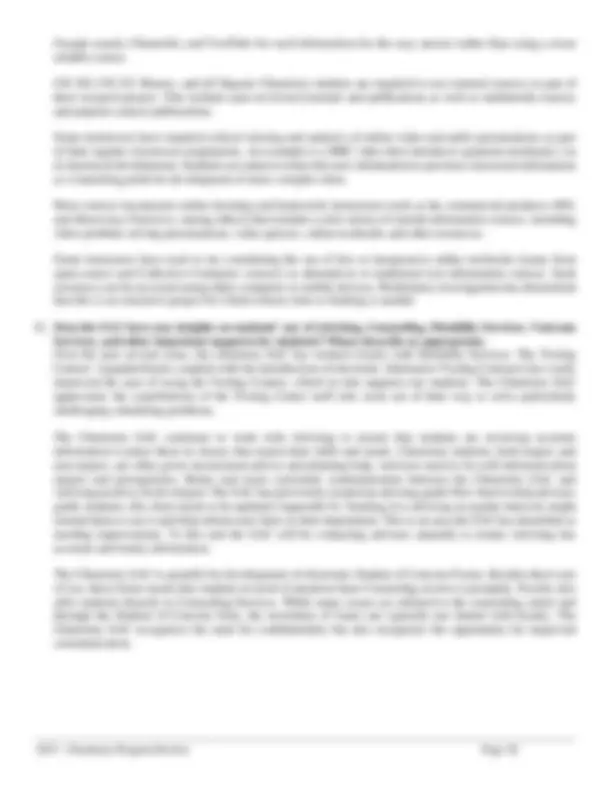
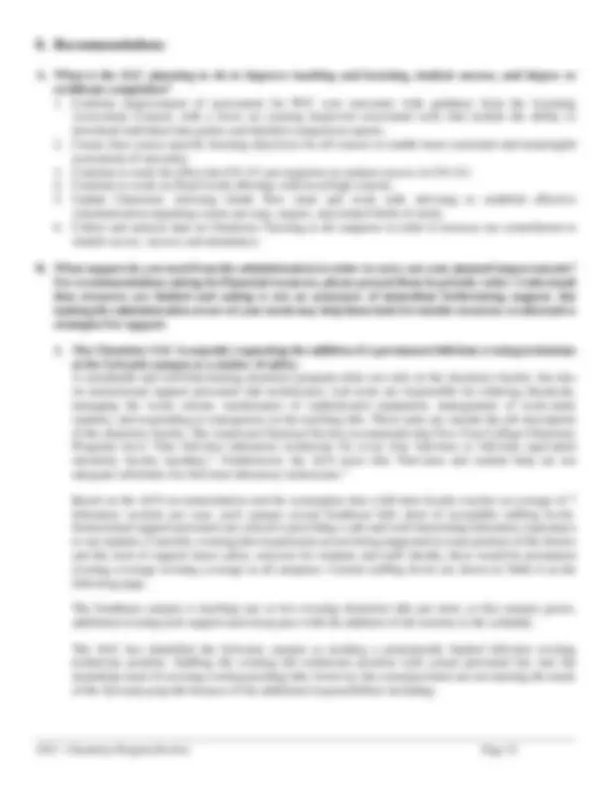
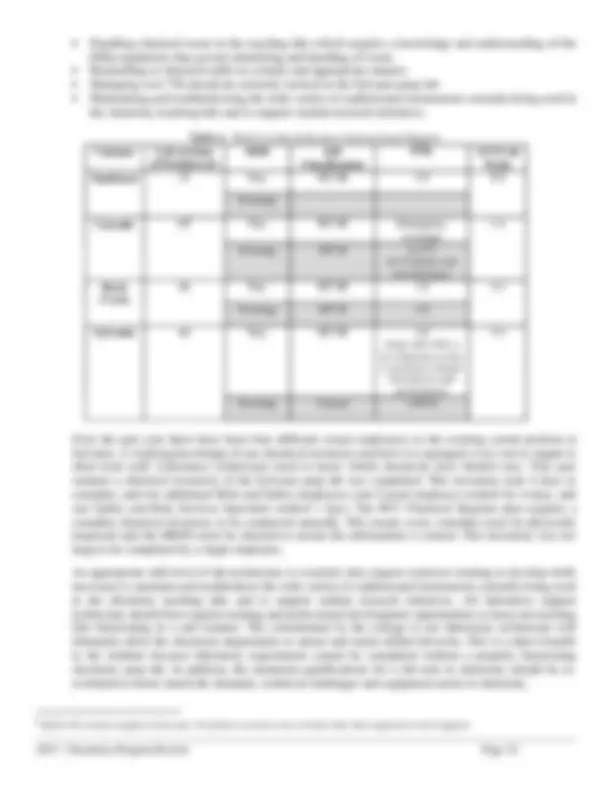
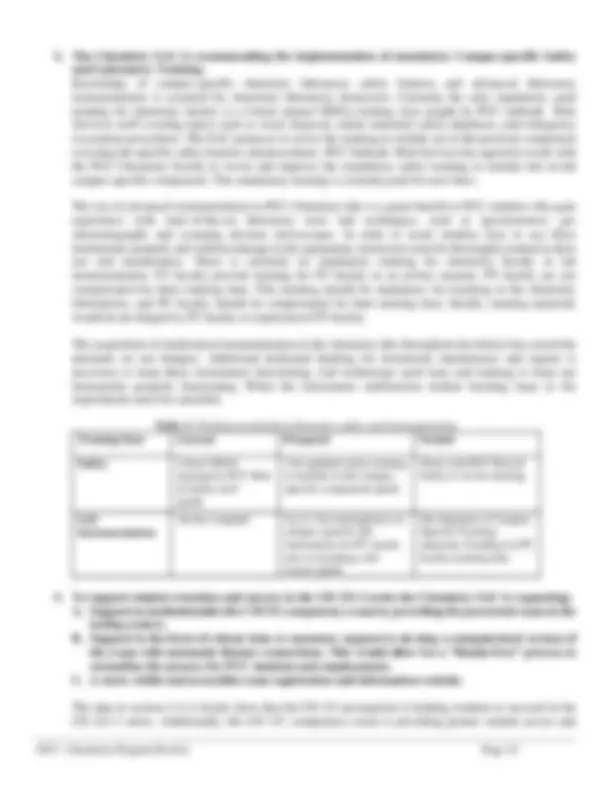
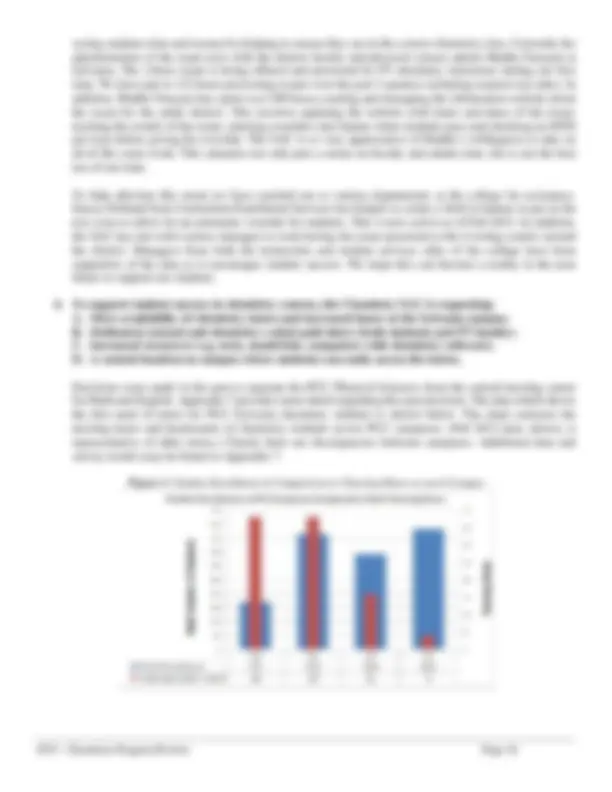
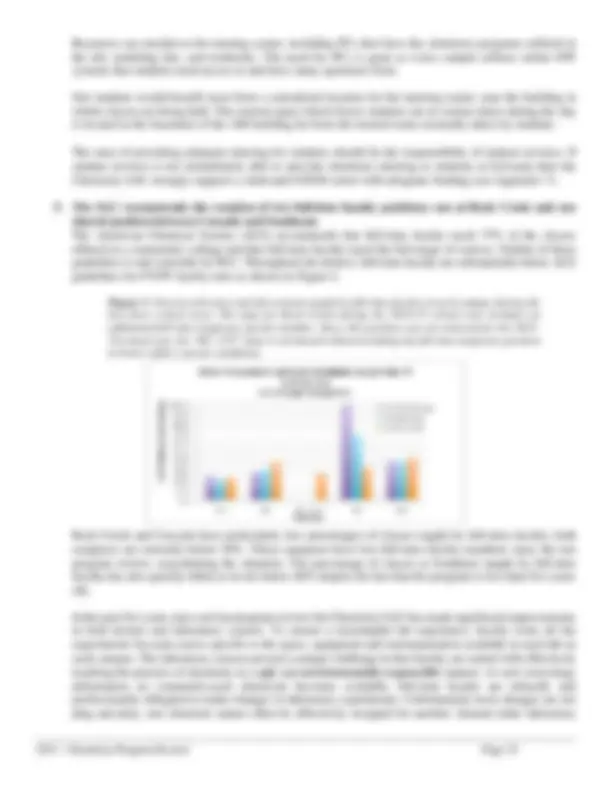
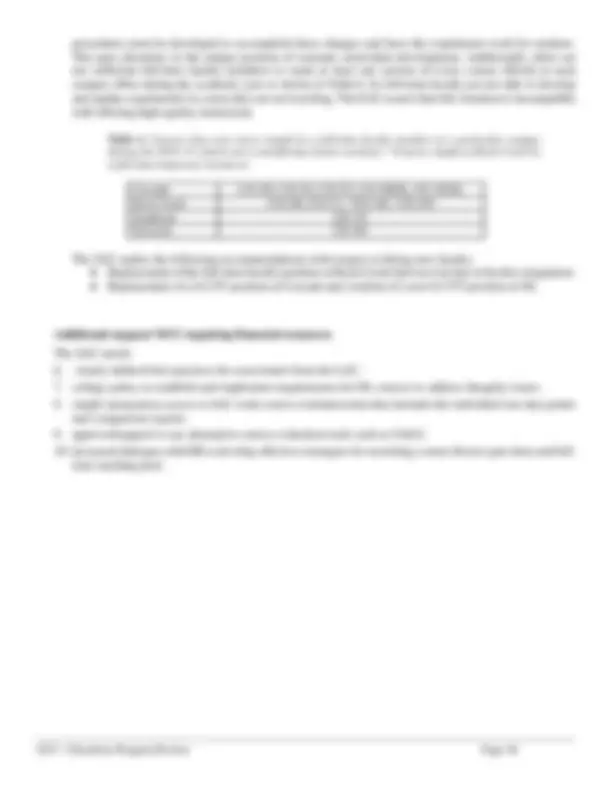
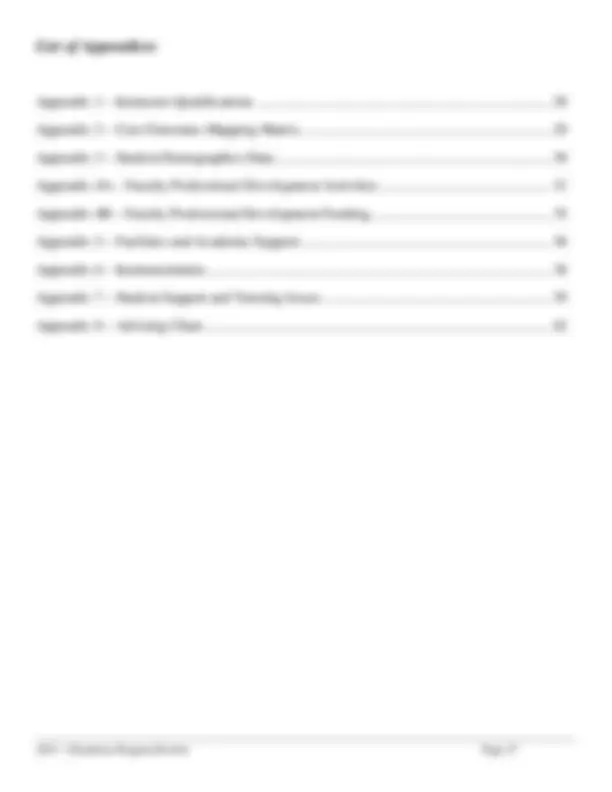
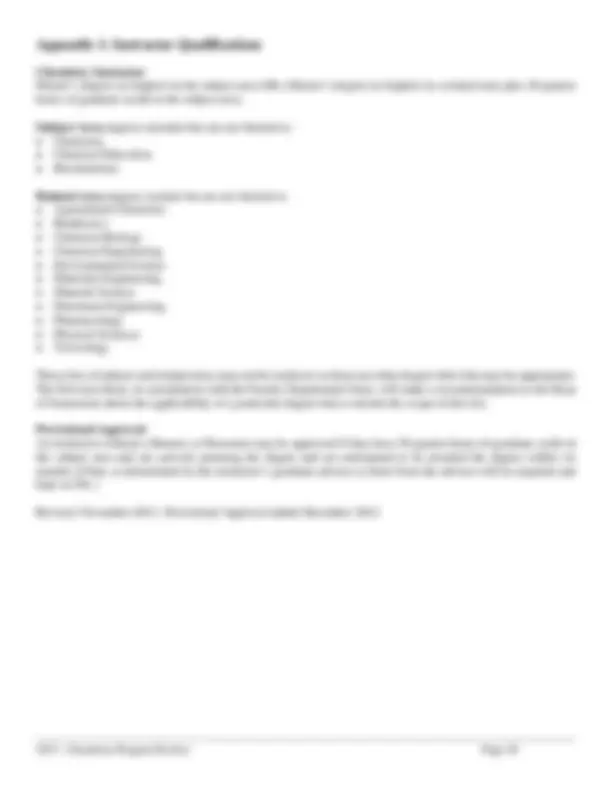
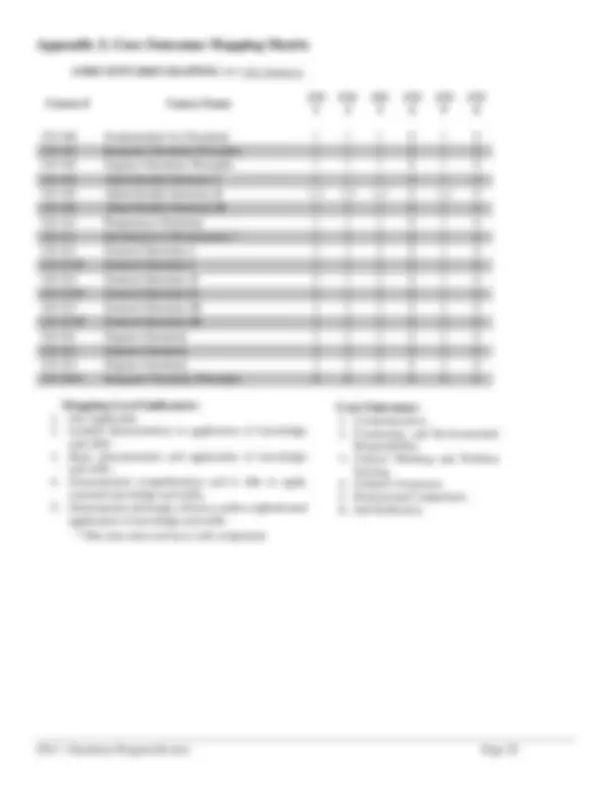
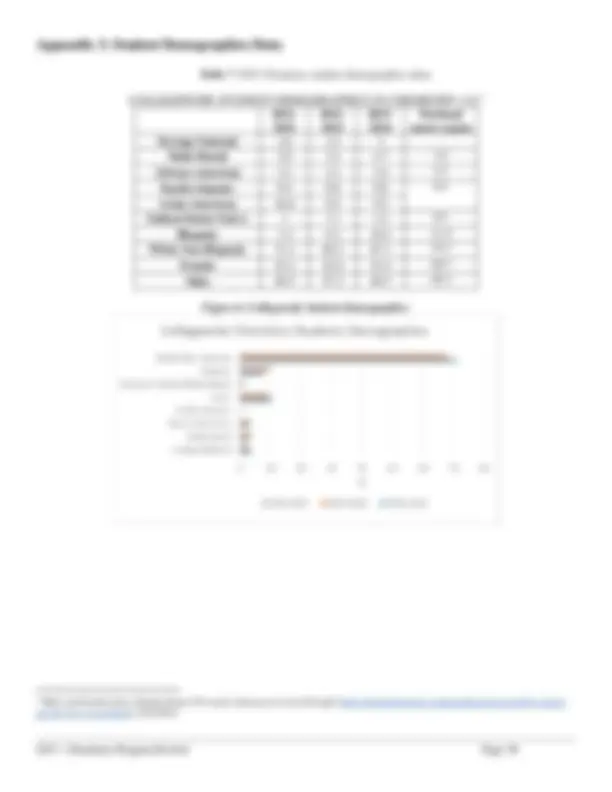
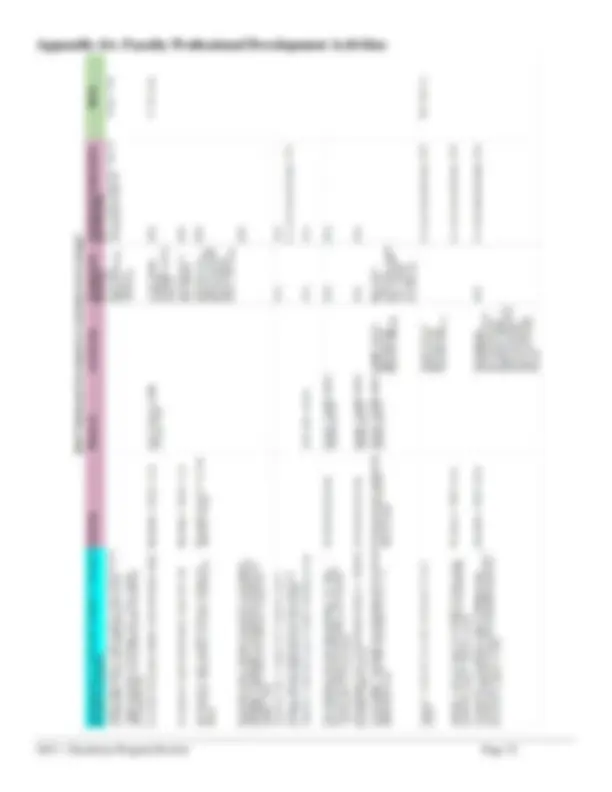
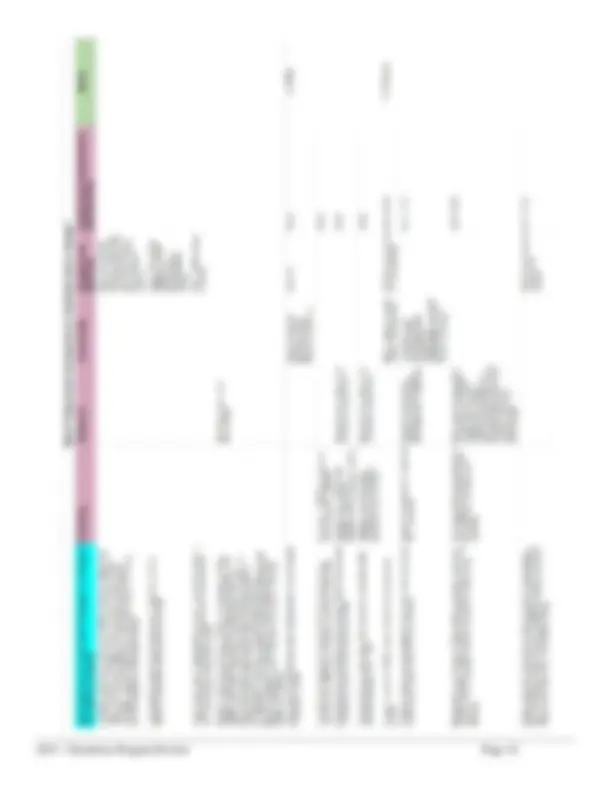
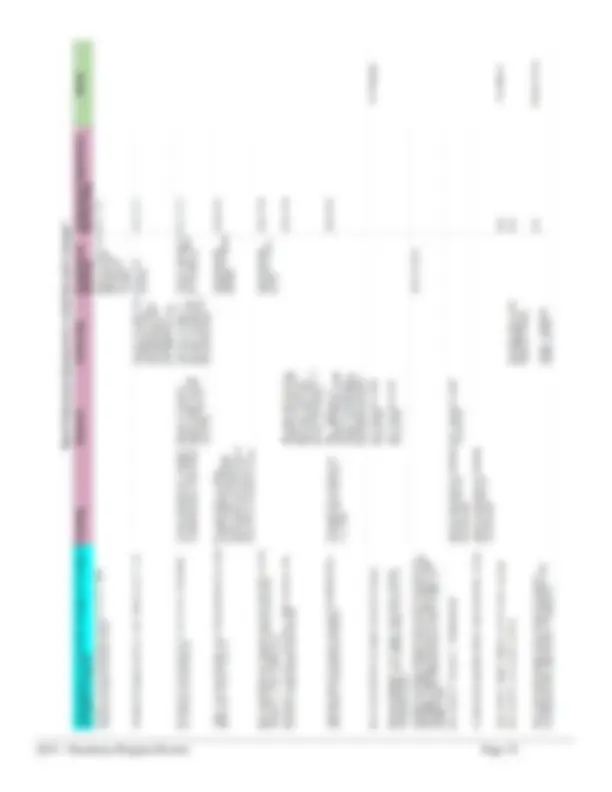
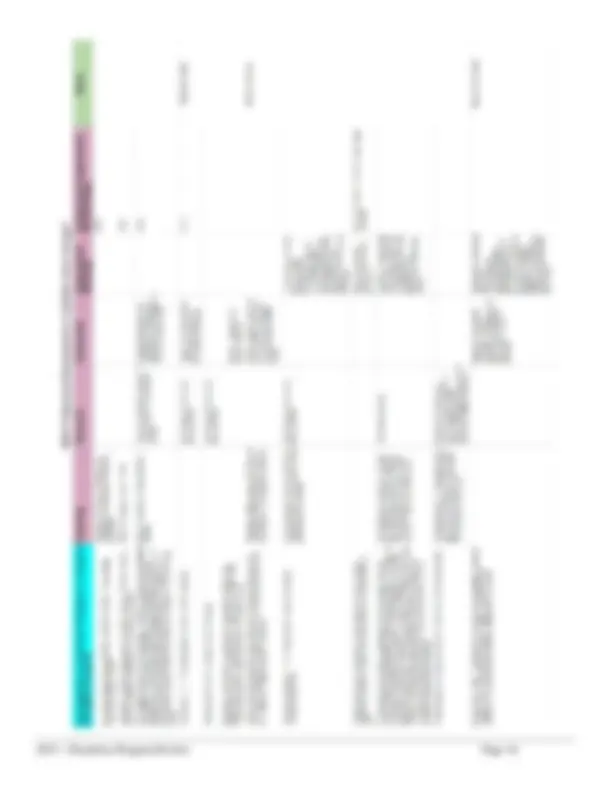
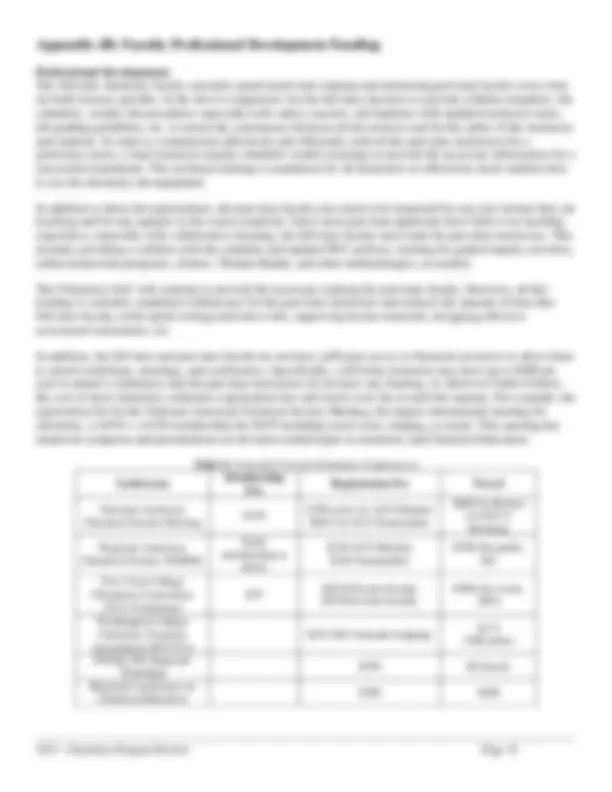
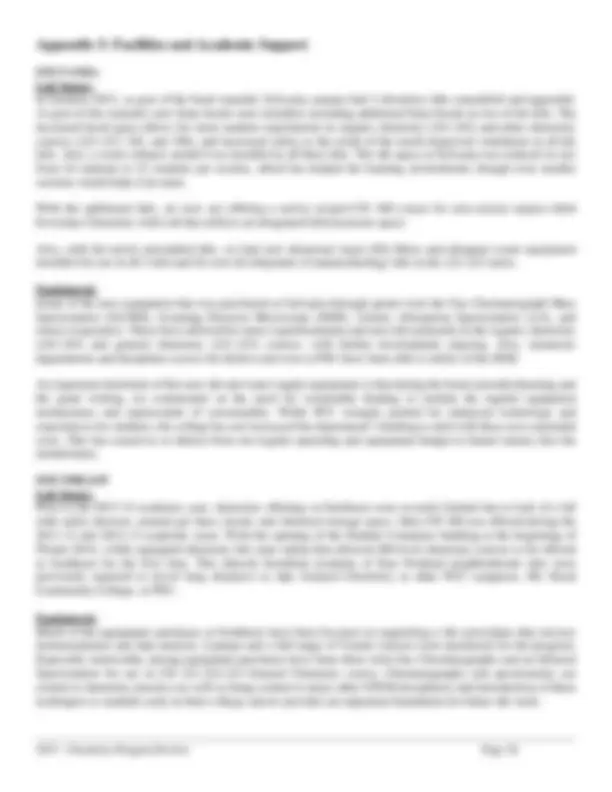
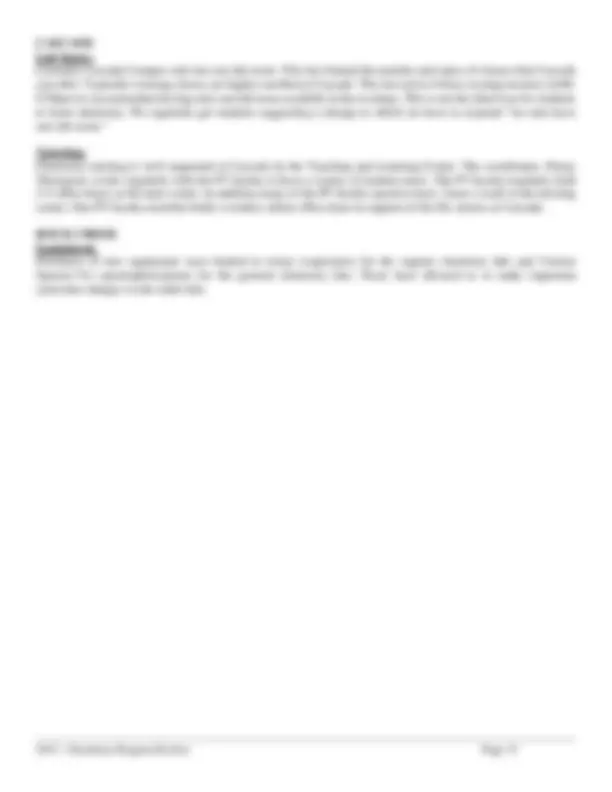
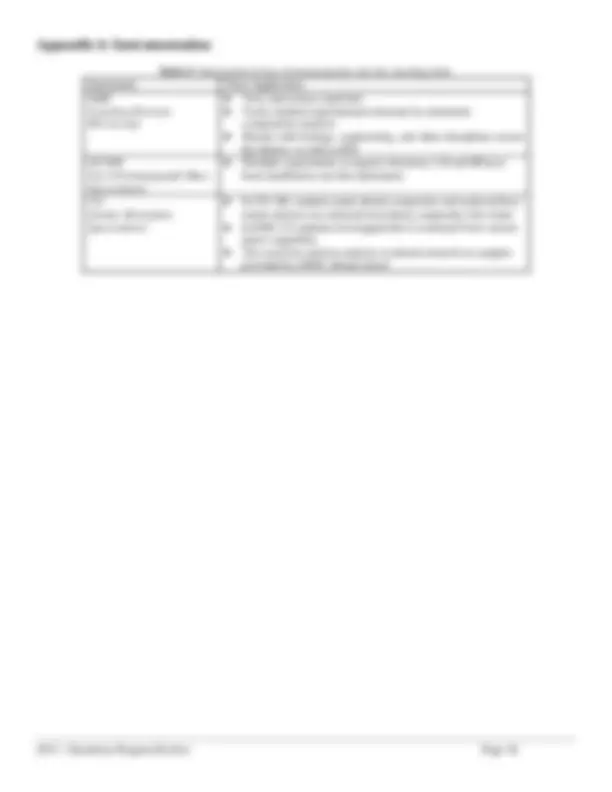
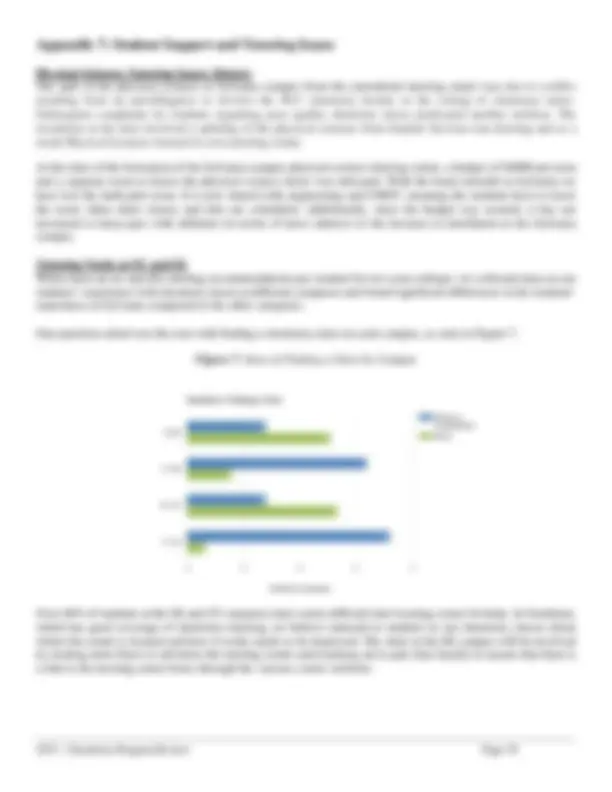
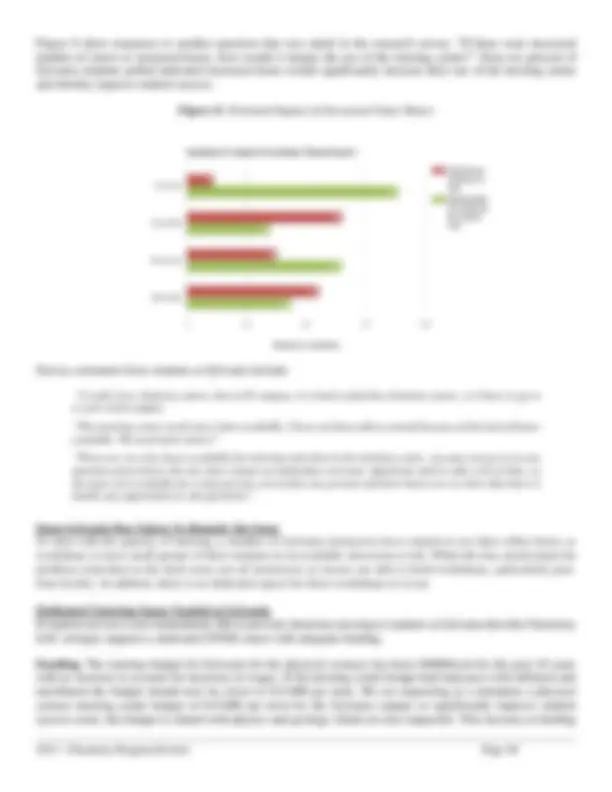
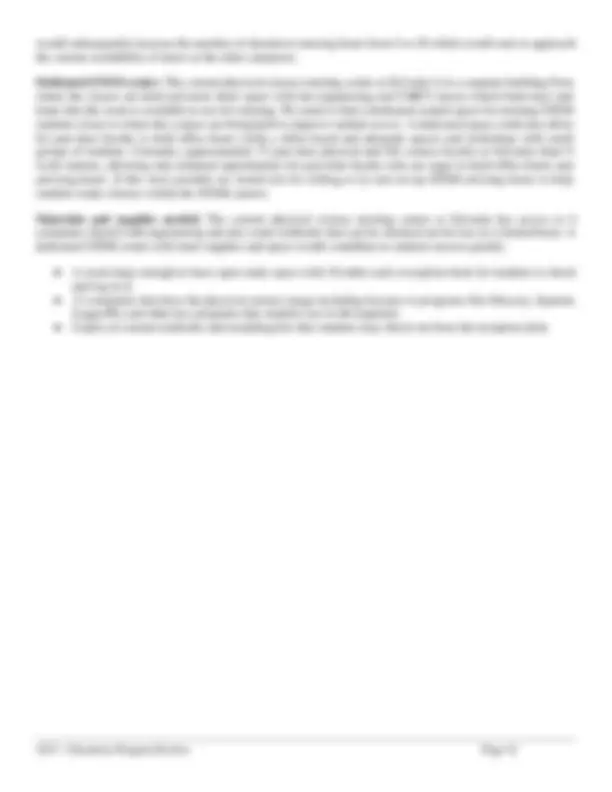
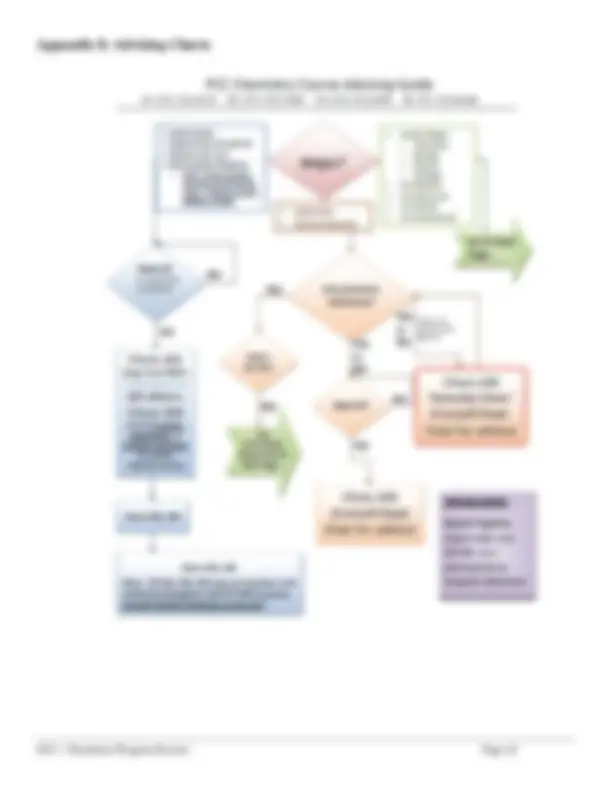
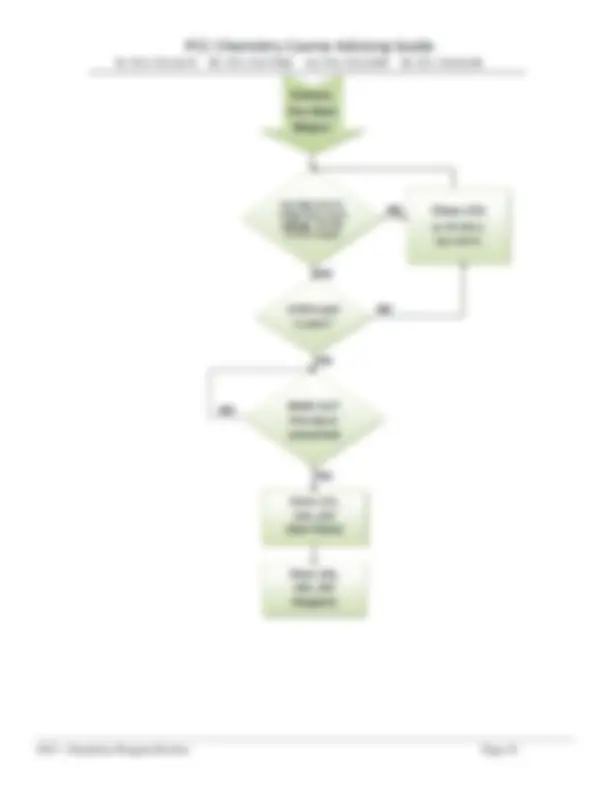


Study with the several resources on Docsity

Earn points by helping other students or get them with a premium plan


Prepare for your exams
Study with the several resources on Docsity

Earn points to download
Earn points by helping other students or get them with a premium plan
Community
Ask the community for help and clear up your study doubts
Discover the best universities in your country according to Docsity users
Free resources
Download our free guides on studying techniques, anxiety management strategies, and thesis advice from Docsity tutors
chemistry principles stressing the interrelationships between organic chemistry and health sciences. The assignment was designed to help students make the ...
Typology: Lecture notes
1 / 43

This page cannot be seen from the preview
Don't miss anything!




































A. What are the educational goals or objectives of this program/discipline? Chemistry is a central discipline for biology, physics, engineering, allied health, medicine, pharmacy and liberal arts. As such, our goal is to prepare students who are continuing their education at a four-year institution, and to introduce chemistry as a science to students who need to fulfill a science requirement for a liberal arts degree, a career, or a technical training certificate.
How do these compare with national or professional program/discipline trends or guidelines? “Chemistry is central to the intellectual and technological advances in many areas of science. The traditional boundaries among chemistry sub-disciplines are blurring, and chemistry is increasingly intersecting with other sciences. Unchanged, however, is the atomic and molecular perspective that lies at the heart of chemistry. Chemistry programs have the responsibility to communicate this outlook to their students and to teach the skills their students need to apply it”^1
Have they changed since the last review, or are they expected to change in the next five years? Our goals are in accordance with PCC core outcomes and national affiliations (ACS) and the goals have not changed since the last program review. However, we regularly revise and update our curriculum based on evolving technology advances and/or development. In addition the chemistry faculty are continually working to apply innovative teaching methodologies to achieve our goals.
B. Briefly describe changes that were made as a result of SAC recommendations and/or administrative responses from the last program review. The following changes were made as of a result of the administrative response to the last program review. The instructor qualifications were updated and are detailed in Appendix 1. In addition, there were numerous SAC-specific requests in our previous program review. Requests are detailed below followed by actions taken.
Faculty Additional Faculty were requested at the Cascade and Rock Creek campuses. The Rock Creek campus added a full-time position effective during the 2011-12 academic year. After a faculty resignation in the fall of 2014, the position was eliminated. The Cascade campus shared a temporary full-time chemistry position with the Southeast campus. That Cascade position has now been moved to the Southeast campus. The net effect in full time faculty staffing is a reduction of one full time faculty member.
Laboratory Resources There were several requests for increased staffing levels of laboratory technicians, additional laboratory equipment, and improvements in facilities.
Additional Lab Support Sylvania hired (with temporary funding) a part-time (40%) lab assistant for the Spring 2010 term, and was expanded to 50% temporary since the 2011-12 academic year. This position is essential when night chemistry labs are offered for the safety of students and faculty. If this position is cut in the future, we will not continue to offer night labs. It should be noted that there has been a high turnover in this temporary 50% position, adding workload to remaining staff and faculty positions responsible for training/support as well as decreasing the functional efficiency of the stockroom.
(^1) This excerpt taken from the 2009 ACS (American Chemical Society) “Guidelines for Chemistry in Two-Year College Programs”. It exemplifies the goals of the Portland Community College Chemistry SAC.
A. Course-Level Outcomes: The College has an expectation that course outcomes, as listed in the CCOG, are both assessable and assessed, with the intent that SACs will collaborate to develop a shared vision for course-level learning outcomes. i. What is the SAC process for review of course outcomes in your CCOGs to ensure they are assessable? We have incorporated grading rubrics to assess student projects and laboratory reports in some of our classes. The rubrics help to ensure that every student is assessed consistently in the same key areas. However, we have realized that we need to be more consistent in terms of evaluator training/norming and we need to add more outcome-specific assessment into our classes. To that extent, three SAC members full-time and part-time faculty attended the Learning Assessment Council class in the Fall of
Three SAC members completed the Learning Assessment and Outcomes Course taught by Wayne Hooke. Information was shared in detail at subsequent SAC meetings with the full SAC. We have rewritten our district-wide Intended Course Outcomes and received positive feedback from Sally Earll, the Coordinator for Curriculum Enrollment Services. The SAC has received extremely positive early feedback on these changes. “Everyone who has read the revisions is impressed with the SACs work to so clearly align the core outcomes to the course outcomes and to provide a mapping level indicator. This shows an incredible commitment on the part of the SAC to be transparent about the value of the core outcomes. We like what you've done and may consider it a model in the future…”
We are in the process of rewriting the Course-Specific Objectives for each of our courses with completion expected summer 2016. The new specific learning outcomes (objectives) clearly define the conditions, skills and knowledge students must demonstrate on exams, in the laboratory and in other course components as well as benchmarks to define the level of mastery students are expected to achieve as a result of successfully completing this course. These new learning objectives will enable the SAC to complete future Outcome Assessments more easily and in a manner that provides relevant feedback on instruction district-wide.
ii. Identify and give examples of changes made in instruction to improve students’ attainment of course outcomes, or outcomes of requisite course sequences (such as are found in MTH, WR, ESOL, BI, CH, etc.) that were made as a result of assessment of student learning. As a result of about 10 years of student surveys and math competency exams across the district we implemented the major changes detailed below.
The most significant change to improve student outcomes was the development of a mandatory preparatory prerequisite course, CH 151, for our General Chemistry sequence. Chemistry at PCC is leading the way in the Pacific Northwest in this area, as nearly all 2- and 4-year colleges and universities still only have “recommended” prior courses for general chemistry. However, our discussions with other colleges and universities have indicated support for such a class. As of Fall 2014, CH 151 Preparatory Chemistry is a prerequisite for CH 221, the first course in the general chemistry sequence. This prerequisite is satisfied by attaining a C or higher in the new CH 151 course, or by passing a CH 151 Competency Exam with a score of at least 70%.
The SAC understands that students might have sufficient knowledge from a high school chemistry class or previous college chemistry class to enter directly in CH 221. In response to this a CH 151 competency exam was created by the SAC. Students are now able to take this exam every quarter at each campus to test out of taking CH 151 and go directly into CH 221. A website was created by the physical science
Instructional Administrative Assistant Madhu Narayan at Sylvania that has a study guide, times and dates for exams and general information about taking the exam. Administration of this exam is currently taken on by the SAC. Our expectation is that PCC will support this important prerequisite exam by moving this placement test to the Testing Center, in line with what is done in the Math and English departments.
Figure 1, shown below, demonstrates the impact of adding the CH 151 requirement on student success in CH 221. In the academic year prior to instituting the CH 151 requirement, 77% of students (979 of
Figure 1 : Impact of the CH 151 Requirement. The chart on the left shows the proportion of students registered for CH 221 who completed the course with a passing grade before (black) and after (grey) instituting the CH 151 requirement. The chart on the right shows the distribution of actual grades earned. The change in percentage points of the proportion of students in each category is noted above each pair of bars.
Increased student success in the first course of the general chemistry sequence can be attributed to increased preparedness of students. Previous difficulties in CH 221 resulted from an unacceptable range of student preparedness from students with no chemistry background and poor math skills to those exceptionally ready in both chemistry and math, all in the same class. Since mandating the preparatory course, faculty have reported a more cohesive and appropriate level of student preparedness.
In light of the increased student success in CH 221 and faculty observations about the level of preparedness of students as a whole, the SAC feels confident that introducing the mandatory preparatory course was the appropriate move. These results are early, and more data should be collected in future years to continue to evaluate the impact of introducing this new requirement.
● Most of the students found the process meaningful/useful towards their attainment of the course outcomes and believed it was a worthwhile experience. ● Students were able to reflect on their experience in a way that the SAC felt was moving them toward the course outcomes. ● Students were able to analyze the experience on a metacognitive level. Students did not just describe what they had done or learned, but reflected on what they did that helped them learn and why it helped them learn. ● Most students were able to see how this self-reflection experience could transfer outside the discipline of chemistry and be useful in other classes as well as outside the classroom. ● Students were able to take ownership of their learning and be critical of themselves as to how well they were doing at attaining the course outcomes. They also were able to talk about how they might change their study habits in the future to attain greater learning.
Project 2: Communication A communication assessment was introduced as part of a pilot program, recommended by the LAC, by one of our instructors.
Most students enrolled in the organic chemistry sequence are majoring in health-related fields such as pharmacy, medicine, nutrition, and physician assistant. To many students, organic chemistry appears merely as a collection of disconnected concepts and facts, where memorization is encouraged over understanding. Likewise many students fail to see how the underlying concepts apply to everyday issues in the health sciences.
Over the past five years one of our instructors has been introducing a ‘Question of the Month’ (QoM), activity that encourages students to come up with a challenging question on their own. We see this as a step toward a more comprehensive understanding of the material, broadening their view on organic chemistry principles stressing the interrelationships between organic chemistry and health sciences. The assignment was designed to help students make the connection of the material covered in class with everyday living chemistry principles. Students were expected to write a challenging question with the following instructions:
Eighteen of the twenty students enrolled in class participated in the writing assignment. All 18 students completed the QoM, each writing one question three times over the course of the term. The 3-week span between each assignment was chosen as it allowed the instructor to provide feedback after each question was turned in. The expectation was to see incremental improvement in the written communication after each task.
Each assignment was evaluated using a rubric. The rubric was adapted from Liberal Education and America's Promise (LEAP) and modified to fit the question of the month. Each written assignment was evaluated separately. Our SAC used three criteria to assess for written communication:
In QoM I, 63% of the 18 students were at or above the benchmark level. That percentage rose to 69% for QoM II. In the final assessment, QoM III, 83% of the 18 students produced assignments at or above the benchmark level.
The Chemistry SAC was recognized by the LAC with a perfect score and awarded the Exemplary Assessment of Student Learning award (we got Smarties!).
ii. Do you have evidence that the changes made were effective (by having reassessed the same outcome)? If so, please describe briefly. The Chemistry SAC recommended the assignments used for assessing self-reflection need to be consistent across the district. The results of our evaluations have shown that these assignments are helping our students develop their self-reflective skills. Due to the modified assessment schedule for the Chemistry SAC, Self-Reflection was not re-assessed prior to this Program Review.
iii. Evaluate your SAC’s assessment cycle processes. What have you learned to improve your assessment practices and strategies? We have discovered over the course of the assessment cycle process that the SAC members themselves need to learn how to write better assessment tools and objectives. Historically the SAC has attempted to create tools and strategies that, while having the potential to be highly informative, are nonetheless incredibly difficult to assess in a way that is meaningful, not incredibly time consuming and easy to implement consistently across the district.
Importantly, through this process and our own self-reflection, we have determined that at present most of our courses have learning outcomes that are not easily assessable. Many of our course outcomes lack clearly assessable benchmarks. Thus, during the 2014-2015 academic year, the Learning Assessment council approved a plan for our SAC to develop sets of course outcomes and learning objectives which, in future assessment cycles, will more directly map to college core outcomes and also lend themselves to be readily assessable across the district by defining clearly assessable benchmarks. Part of this revision included the pilot study in Winter 2015 described in Project 2: Communication above (See part C, i).
Completion and evaluation of this pilot study are intended to put the SAC on a more meaningful assessment cycle. We expect the improved outcomes and benchmarks to provide a more uniform student experience across the district, as well as better connecting our core course outcomes to those of the college as a whole.
iv. Are there any Core Outcomes that are particularly challenging for your SAC to assess? If yes, please identify and explain. The SAC has found Cultural Awareness to be the most challenging core outcome to assess. While of course the SAC recognizes that cultural awareness is an important outcome for any student or citizen, the rigor and subject matter of chemistry does not lend itself easily to ready inclusion of this outcome. In addition to the inclusion of the other core outcomes, chemistry courses must also focus on higher order thinking skills, process-oriented skills, competence in a laboratory/hands-on setting, and safety and environmental awareness, all within the context of conceptually and often mathematically challenging subject matter, merely as the course of the day. Our students must be ready to compete in challenging and highly competitive courses of study when they transfer to 4-year colleges and universities or other professional programs. The inclusion of cultural awareness to the extent that it could be given due diligence during most of our courses is simply very difficult in light of all the other critical thinking, content-specific and skill-based content that must be included in our courses to enable students to be successful beyond PCC.
Table 1. Percentage of chemistry courses online and district pass rates for On Campus vs. DL (2010-2014)^4 Course CRNs Online (%)
On-Campus Pass Rate (%)
DL Pass Rate (%)
CH 100 33.0 78.4 61.
CH 104 25.9 83.3 76.
CH 105 27.3 90.9 82.
CH 106 37.8 98.5 81.
CH 221 7.7 74.7 77.
CH 222 10.5 79.7 78.
CH 223 9.2 76.9 81.
The shells for the CH 104-6 series are now 7 years old. We have learned a great deal about how best to organize and present chemistry during this time period. Although the courses are continually updated in small ways by the faculty teaching DL, more intensive updates are needed. Updating DL courses is time consuming; however it is important to make changes to keep up with technology and pedagogical changes. To address this, a team of PT and FT faculty was chosen to review and update CH 104. This team has been awarded IIP and Media Camp funding for course upgrades. The SAC hopes to update the entire series in a timely fashion, but with summer being the only real time to make such significant changes we are looking at a slow process without extra support from administration. Disability Services is working with the SAC to ensure that these older courses are accessible.
A number of academic integrity issues have surfaced. These include submission of lab reports that are from students who were previously in the course, students paying others to take the course for them, not buying a lab kit and falsifying data and students working together on at-home exams. The SAC understands that these are issues in all DL classes at PCC. The SAC is looking to the administration and the DL department to provide support in dealing with and helping to prevent these issues. While we wait for the college to decide how to best handle these integrity issues we have made a few changes to improve the situation. Two mandatory on-campus exams in the CH 221-3 hybrid series at Rock Creek are given during the term and at Cascade and Sylvania most DL courses require students to send pictures of themselves completing the labs at home.
B. Has the SAC made any curricular changes as a result of exploring/adopting educational initiatives (e.g., Community-Based Learning, Internationalization of the Curriculum, Inquiry-Based Learning, Honors, etc.)? If so, please describe. Through the enthusiasm, skills and interests of its full-time and part-time faculty, the Chemistry SAC focuses on the importance of incorporating pedagogically sound initiatives into the curriculum. Several of these initiatives are campus- or course-specific due to the interests of individual instructors or teams. The diversity of offerings provides many options for achieving course outcomes across the district. Curricular changes since our last program review include: ● Distance Learning o The CH 100 Everyday Chemistry course is fully online and ADA compliant for both lecture and lab components. This online course has been offered every term since Fall 2013. o The CH 104-106 series is in the process of updating the online courses to become ADA compliant.
(^4) Data found in PCC IE website, from file on DL and on-campus courses info: (DL and on campus course success rate file) at http://www.pcc.edu/ir/program_profiles/
● Undergraduate research o The CH 298A research course has been approved by the EAC. While several faculty are interested in offering individual research opportunities to students, there is currently no system in place to compensate instructors or record FTE. The chemistry SAC voted not to offer the course until bargaining with the PCCFFAP is complete in 2015. Additionally work is being done to ensure the course transfers for chemistry major elective credit to PSU with the eventual goal of have these credits accepted throughout the Oregon University System. o Multiple-week field lab projects offered in some CH 100, 105 and 151 sections engage students in the process of scientific inquiry. With guidance, students develop a research question, propose an experimental plan, calibrate instruments and collect data in the streams around campus, analyze the data graphically, create a results statement, and draw conclusions relating to water quality in our watershed. o Organic Chemistry III students engage in a research project in which they study the literature, choose a project, complete the chosen experiment and present the results either through an oral presentation to the class and/or at the annual Chemistry Poster Fair at the Rock Creek Campus. o Guided-inquiry labs in some sections mimic the research experience by setting up a problem for students to investigate on a topic not yet covered in lecture. Students learn to analyze the empirical data obtained in the experiment and evaluate reliability of their data when no reference or “right answer” is available. o A key requirement for the “Honors” designation for the CH 221-223 General Chemistry course is a literature or experimental research component in which students must “apply chemistry-based scientific research methods to investigate questions relevant to student’s individual interests and to make connections to other sciences and/or the humanities” (from the CH 221H-223H CCOGs). o Several students have worked on research projects under the guidance of some instructors at Sylvania. For example, one student in a science teaching program at PSU worked over the course of 2 summers and 2 academic years, both through work study and volunteer, to research nanotechnology-based labs at Sylvania. These labs have been implemented into the general chemistry curriculum. Other students have volunteered to work as lab assistants in the general chemistry labs as peer facilitators. These students reflect upon their experience, provide feedback and help to update and upgrade the laboratory experiences.
● Sustainability o Greener organic chemistry labs have been developed that utilize fewer hazardous substances in smaller quantities. Students in CH 241 and 242 synthesize compounds using green chemistry techniques and then reflect on the aspects of the experiment that made it green. The Rotary Evaporators purchased for the Rock Creek and Sylvania campus since last program review enable PCC to comply with EPA and OSHA standards by capturing organic solvents versus removing them through evaporation. o The newly-repurposed CH 100 course uses sustainability issues such as water and air quality, global climate change, and energy resources to frame chemistry learning for non-majors in several sections. o The field lab projects described in “Undergraduate Research” focus on the water quality of surface water on campus or in the local area. As part of the project, students research water quality concerns and standards and connect their data to those standards.
● Honors Program o CCOGs for Honors sections of the entire general chemistry sequence (CH 221H-223H) were approved. The CH 221H Honors General Chemistry course was developed and taught Fall 2013. Feedback and self-reflection indicated the need for further revision in light of the recent CH 221 prerequisite changes, as well as better alignment with the goals of the Honors program. The SAC plan for updating the Honors courses is to initiate a dialogue with the Honors Program to determine if a introductory level course such as CH 100 would better serve our students’ needs.
Figure 2. Results of the district-wide Course Evaluation question: “If a lab course, proper use and care of lab equipment was explained and enforced”
Drawbacks
Historically many chemistry instructors used a tool called SALG (Student Assessment of Learning Gains) which consistently provided a response rate >90% for those instructors. This student feedback form gave much greater flexibility and allowed assessment of The Class Overall, Specific Class Activities, Assignments and Graded Activities, Class Resources, Information Given to Students, Support as an Individual Learner, Understanding of Class Content, Increase in Skills, Class Impact on Attitudes (towards chemistry), and the Integration of Learning and Overall Classroom Experience. In addition, the SALG tool allows instructors to see which students responded, although individual responses were anonymous. While a complex tool of this nature may not be possible district wide, the instructors’ use of their own end-of-term evaluations in addition to the PCC-mandated evaluation has been discouraged. Since more-informative feedback tools can’t be used any later than the 8th week of the term, potentially valuable student summative feedback can no longer be obtained in the manner that is useful for curricular change.
The Chemistry SAC strongly desires a greater opportunity to use a more useful feedback tool.
E. Identify and explain any other significant curricular changes that have been made since the last review. The CH 100 Fundamentals of Chemistry course offered prior to Fall 2013 served two populations of students: those who take the class for a General Education science class with a lab and those preparing to take the
majors-level general chemistry series. The Chemistry SAC decided to split these two populations into two different courses to better serve both populations of students. The new classes are CH 100 and CH 151.
CH 151, a new preparatory chemistry class, was developed to serve students entering our majors CH 221 sequence, the Veterinary Technology program, the Bioscience Technology program, and the Microelectronic Technology program. It has also become a prerequisite for BI211, a class designed for students majoring in biology and the sciences, including pre-medical, pre-dental, chiropractic, pharmacy, and related fields.
The new CH 100 class now serves primarily the GenEd Population. This class is a much better fit for our non- science majors who need a science class to fulfill their GenEd requirement.
CH 221H, an honors version of CH 221, was offered in Fall 2013 at the Sylvania campus as a pilot course. Students were expected to be math-ready and have had appropriate preparatory chemistry experience. Major deviations from the regular CH 221 curriculum included a term research project on nanotechnology with final oral presentation, omission of curricular units on background math, problem solving and introductory chemistry, and a new suite of 6 labs introducing nanotechnology and the synthesis and characterization of controlled-growth multi-sized silver nanoparticles. The labs related directly to the course content but focused on cutting-edge technology. Subsequent honors courses, although planned, were not taught after consideration of the general unpreparedness of most of the students for a laboratory science class at the general chemistry level. Discussions with the Honors Council ensues regarding future introduction of a general chemistry honors sequence in light of the new CH 151 prerequisite for CH 221 (see above).
CH 101 was developed at the Sylvania campus. This course was designed specifically for students enrolled in the Civil and Mechanical Engineering Technology (CMET) program at Sylvania, although it does meet general education transfer credit requirements for any student. The course was designed to better serve the needs of the CMET program students, and was created with much advice from a number of CMET faculty. The course was implemented in the Winter and Spring terms of 2012. Further discussions with the CMET faculty resulted in the CMET student class schedule being altered such that this course now directly precedes the one for which it is a pre-req, and therefore better integrated directly into their program. The course is now taught once per year in conjunction with the CMET program schedule.
For our CH 221 classes, MTH111 has become a prerequisite, rather than a co-requisite as previously discussed in question 2A.
A. Have there been any notable changes in instruction due to changes in the student populations served? We have not made any significant changes in instruction due to changes in the populations served since we have not observed any significant demographic changes. Student demographics in Chemistry courses are shown in Appendix 3.
B. What strategies are used within the program/discipline to facilitate success for students with disabilities? What does the SAC see as particularly challenging in serving these students? Chemistry instructors provide assistance and resources for students with disabilities in accordance with The Americans With Disabilities Act. We work closely with students and Disability Services to meet the specific needs of students with disabilities.
As of academic year 2013-2014, all new PCC D2L courses were required to be accessible. The SAC found this to be extremely challenging for all DL courses. Enormous amounts of time have been spent and continue
Figure 3. Chemistry courses taught by full time faculty. Data from IE. Data from Fall 2014 have been calculated without the temporary full-time position at Rock Creek to more accurately reflect the percent full-time faculty for the next academic year. Our 2014 percent falls below the College average of 37% of sections taught by FT faculty and well below the 75% recommended by the ACS.
B. Changes the SAC has made to instructor qualifications since the last review and the reason for the changes. Current Instructor Qualifications are listed in Appendix 1, and can be found at http://www.pcc.edu/resources/academic/instructor-qualifications/index.html
The chemistry SAC implemented a number of changes to our instructor qualifications. The majority of the changes were made November 2011. The instructor qualifications were expanded to include full-time and part-time chemistry instructors at PCC. In addition to Chemistry, Chemical Education and Biochemistry were added to the accepted main subject area degrees. The expansion of prominent subfields within the field of chemistry over the past 20 years influenced the SAC to make this change.
The list of related subject area degrees was expanded (see Table 2). The appearance of new degrees in related fields influenced the SAC to make this change.
Table 2. Chemistry-related Fields Related Fields before Nov 2011 Related Fields after Nov 2011 Agricultural Chemistry Biochemistry (moved to main subject area) Biophysics Biophysics Chemical Biology Chemical Education (moved to main subject area) Chemical Engineering Environmental Science Environmental Science Materials Engineering Material Science Material Science Petroleum Engineering Pharmacology Pharmacology Physical Sciences Physical Sciences Toxicology Toxicology
Additionally a clear procedure for obtaining approval for a degree in the related field list was included. The SAC wanted a clear set of guidelines to maintain parity between the campuses. The new guidelines are as follows:
C. How have the professional development activities of the faculty contributed to the strength of the program/discipline? If such activities have resulted in instructional or curricular changes, please describe. Both full-time and part-time Chemistry SAC members engage in professional development activities to stay current in their knowledge, improve their teaching, and provide access to STEM activities through community outreach. Below are several examples of professional development activities, curricular changes and outreach activities the Chemistry Faculty have engaged in since our last program. A full listing of each faculty member’s professional development activities are given in Appendix 4A.
Professional Associations, Conferences, and Workshops
Curricular Changes
Table 3: New Equipment and Lab/Tutoring Space Campus Equipment Lab Spaces
Tutoring
Sylvania GC/MS SEM Rotovaps Flame AA High Purity Water system FTIR
3 Shared room with engineering
Southeast FTIR Vernier GC Vernier Equipment Laptops
0.8 Tutoring Center
Cascade Vernier GC Vernier Equipment GC
1 Tutoring Center
Rock Creek FTIR Rotovaps Vernier MiniGC Vernier UV/Vis Vernier Equipment HPLC
3 Tutoring Center
The Chemistry SAC is extremely proud of the investment the college has made in lab equipment and space over the last five years. Specific examples of integration of the equipment into teaching labs are detailed in Appendix 6.
The implementation and continued use of new equipment presents significant challenges: ● Maintenance costs (tech and software upgrades) ● Repairs ● Curator time (upkeep, training, etc.) ● Instructor training ● Consumables needed to run the instruments such as gases and solvents ● Development time for new experiments
The addition of this instrumentation has not been paired with an increase in dedicated departmental funding for consumables and maintenance, dedicated training funds for lab technicians and part-time faculty, and funding or release time for experiment development. This is crucial to ensure the long-term viability of our program and student success.
B. Describe how students are using the library or other outside-the-classroom information resources. The library website has links to multiple useful reputable sources available to assist students. This list includes full text for over 890 peer reviewed health and life sciences journals, the CRC Handbook, an online version of McGraw-Hill Encyclopedia of Science & Technology, as well as other research databases for locating journal articles.
Students are required to obtain physical data to prepare for experiments, to write formal reports and to complete pre-lab assignments. Safety precautions are also part of the pre-lab assignments where students are required to look up chemical properties of the materials they are expected to use in each lab. Included on the library website are links to MSDS, NIST, EPA, PubChem and WebElements which are reliable and reputable sources for such material. However, it has become common for students to become complacent and use
Google search, Chemwiki, and YouTube for such information for the easy answer rather than using a more reliable source.
CH 102, CH 221 Honors, and all Organic Chemistry students are required to use external sources as part of their research project. This includes peer-reviewed journals and publications as well as multimedia sources and popular science publications.
Some instructors have required critical viewing and analysis of online video and audio presentations as part of their regular classroom assignments. An example is a BBC video that introduces quantum mechanics via its historical development. Students are asked to relate this new information to previous classroom information as a launching point for development of more complex ideas.
Most courses incorporate online learning and homework instruction (such as the commercial products OWL and Mastering Chemistry , among others) that includes a rich variety of outside information sources, including video problem solving presentations, video quizzes, online textbooks and other resources.
Some instructors have used or are considering the use of free or inexpensive online textbooks (many from open-source and Collective Commons sources) as alternatives to traditional text information sources. Such resources can be accessed using either computer or mobile devices. Preliminary investigation has determined that this is an extensive project for which release time or funding is needed.
C. Does the SAC have any insights on students’ use of Advising, Counseling, Disability Services, Veterans Services, and other important supports for students? Please describe as appropriate. Over the past several years, the chemistry SAC has worked closely with Disability Services. The Testing Centers’ expanded hours coupled with the introduction of electronic Alternative Testing Contracts has vastly improved the ease of using the Testing Centers, which in turn supports our students. The Chemistry SAC appreciates the contributions of the Testing Center staff who went out of their way to solve particularly challenging scheduling problems.
The Chemistry SAC continues to work with Advising to ensure that students are receiving accurate information to place them in classes that match their skills and needs. Chemistry students, both majors and non-majors, are often given inconsistent advice and planning help. Advisors need to be well informed about majors and prerequisites. Better and more consistent communication between the Chemistry SAC and Advising needs to be developed. The SAC has previously created an advising guide flow chart to help advisors guide students; this chart needs to be updated (Appendix 8). Sending it to advising at regular intervals might remind them to use it and help inform new hires in their department. This is an area the SAC has identified as needing improvement. To this end the SAC will be contacting advisors annually to ensure Advising has accurate and timely information.
The Chemistry SAC is grateful for development of electronic Student of Concern Forms. Besides their ease of use, these forms insure that students in need of attention from Counseling receive it promptly. Faculty also refer students directly to Counseling Services. While many issues are referred to the counseling center and through the Student of Concern form, the resolution of issues are typically not shared with faculty. The Chemistry SAC recognizes the need for confidentiality but also recognizes the opportunity for improved communication.